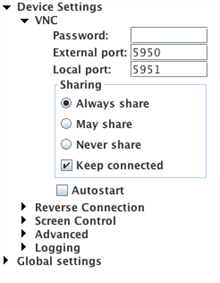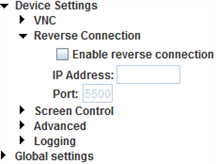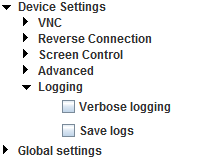You can use the settings options in Android Gateway to customize the application and to specify special circumstances for connections. Although the default settings are fine for most devices and environments, you might need to make adjustments from time to time.
Settings options are located in the Settings sidebar on the right side of the application window. Most settings are saved specific to the device selected in the Device Table section. Therefore, if you have multiple devices connected, the settings displayed in the sidebar change if you select a different device.
Settings are saved in a configuration file on the device itself. When you reattach a device, Android Gateway reads any settings customizations that are saved on the device, so you don't have to configure your connections again. The exceptions to this behavior are the choices under Global Settings, which apply to all devices and connections.
The Settings Sidebar
The Settings sidebar is divided into categories. To see the options available in a section, click the icon beside the heading or double-click the heading itself to expand the section. Descriptions of each section and the settings available in each follow.
VNC
The options in this section specify information about the VNC connection.

- Password: (Optional) Use this field to set a password for the VNC server on the device. You'll need to enter the same password when you create a connection from Eggplant Functional. For information about Eggplant Functional connections, see Creating Connections to SUTs.
- External port: Android Gateway uses the external port for connections with Eggplant Functional running on a different machine. ポート転送を動作させるため、外部ポートはローカルポートとは異なるものでなければなりません。 The default port is 5900. Note: If you're connecting to multiple devices simultaneously, you must use a different port for each connection.
- Local port: Use this port to connect from Eggplant Functional running on the same machine as Android Gateway. デフォルトポートは5950です。
- Sharing: These settings determine whether or not there can be allow multiple VNC connections at the same time.
- Always share: Always allow multiple connections.
- May share: Uses the settings from the Eggplant Functional Connection Preferences tab.
- Never share: Never allow multiple connections.
- Autostart(オートスタート):デバイスを再接続するときにサービスを自動的に開始させる場合に、この設定を使用します。 If this checkbox is selected, Android Gateway starts the service as soon as it recognizes the device. Not selected by default.
Reverse Connection
Use this section to set options to establish a reverse VNC connection. For instructions to make reverse connections, see Making a Reverse Connection with Android Gateway.

- Enable reverse connection: Select this checkbox to enable a reverse VNC connection—a connection that is initiated by the Android SUT rather than by the computer running Eggplant Functional.
- IP address: Use this field to enter the IP address of the Eggplant Functional machine when you're using a reverse VNC connection.
- Port: Use this field to set the port number over which Android Gateway communicates the reverse VNC connection. Note that Eggplant Functional must be configured to listen for reverse connections on the same port number. You can set the port in Eggplant Functional by going to Eggplant > Preferences and selecting the Connection tab. The default port is 5500.
Screen Control
Use these options to manage aspects of how the device screen is presented to Eggplant Functional.

- Enable unicode: Selected by default. Allows the Unicode keyboard to work on the device.
- Enable rotation: Selected by default. This setting allows you to control whether a device's display rotates.
- Max frames/sec(最大毎秒フレーム数):リモート画面描画のためにデバイス上でスクリーンショットを撮る速度を制限できます。 この値は、毎秒フレーム数(FPS)で指定されます。 Using a larger number of frames per second makes devices more responsive but can drain the battery even when the device is plugged into a power source. デフォルト値は5です。 ほとんどのデバイスは、1秒間に5枚を超えるスクリーンショットを撮ることができません。
- Blend pixels when scaling(スケーリング中にピクセルをブレンド): スケーリングを使用する場合は、このオプションを使用してより良い画像を得られます。 しかしブレンドを利用すると、パフォーマンスが遅くなる傾向があります。
- Compatibility mode: This feature is not enabled by default for most devices. This provides the best touch gesture support. However, some devices work better in compatibility mode. ピンチおよびロングホールドといった一部のタッチジェスチャーは、互換性モードではサポートされていません。 Note: Compatibility mode is enabled by default the first time an LG G5 device is connected to Android Gateway.
- Local screenshots: Selected by default when an LG G5 device is connected to Android Gateway for the first time. Configures the SUT to allow the screenshots seen in Eggplant Functional during automation.
Advanced
This section includes advanced settings options. ほとんどの場合、これらの設定を変更する必要はありません。 本画面上のオプションを以下で説明します。

- Range of ports used on device: Android Gateway uses one port to communicate internally within the connected device. Min(最小)およびMax(最大)フィールドで指定されたポート範囲からポートを選択します。 電話上で実行中のアプリと対立するポートがある場合は、ここでポート範囲を調整できます。
- Allow autoreboot: Select this checkbox if you want Android Gateway to automatically reboot the device if it encounters multiple failed connections.
- Custom parameters(パラメータをカスタマイズ):デバイスに接続を行うときに使用するパラメータを記入できます。 A list of allowable parameters can be found in the Help menu. Note: This feature should be used only as directed by Eggplant technical support.
ログ取得
This section lets you make choices about the logs Android Gateway keeps.

Verbose logging: This setting enables extensive logging for debugging.
Save logs: Select this checkbox if you want to save a log file.
Global Settings
This section is where you set application options that not device-specific.

ADB version: Use the drop-down list to select the appropriate Android Debug Bridge (ADB) version for your device. Android Gateway supports ADB versions 1.0.31, 1.0.32, 1.0.36, and 1.0.39. Be sure to switch the ADB version here before you start the connection service. The ADB version you select persists between Android Gateway sessions.
Logging dir: This field displays the path to the application home directory, which is where logs are saved if you enable that feature in the Logging section.